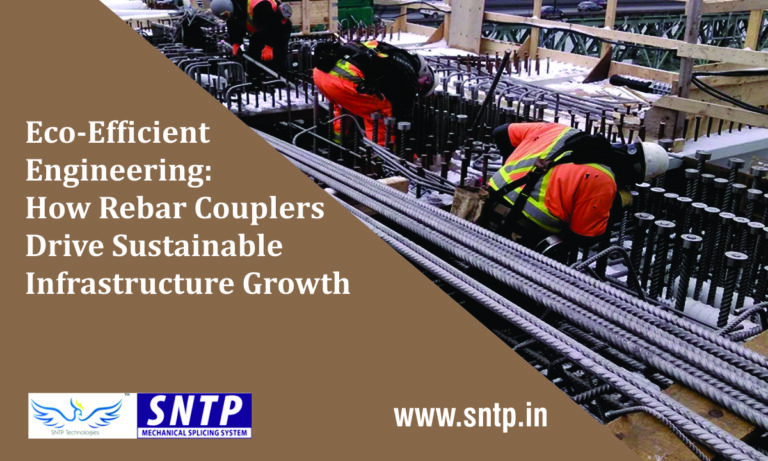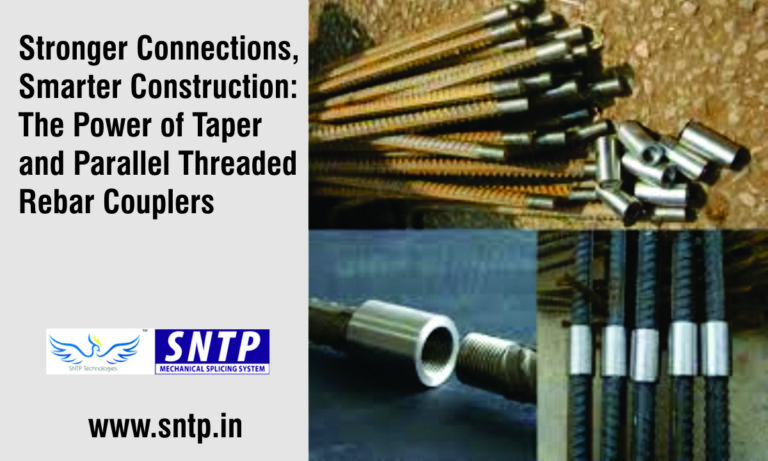+91 9953 65 9594

Rebar Couplers for Faster Completion and Higher Profit Margins
Introduction
In the world of construction, two things define success—speed and profitability. For Indian builders, developers, and contractors, project delays often lead to higher costs, penalty clauses, and reduced margins. To stay competitive, the industry needs solutions that not only save time but also reduce wastage and ensure structural safety.
One such solution making waves in modern construction is the rebar coupler. By replacing traditional lap splicing with a faster and stronger alternative, rebar couplers allow projects to finish earlier, save steel, and maximize profit margins—all while ensuring compliance with Indian Standards.
The Limitations of Lap Splicing
For decades, India has relied on lap splicing, where two rebars are overlapped and tied together with wire. While this method is familiar, it comes with several limitations:
- Excessive Steel Wastage: Overlapping rebars requires additional steel length, sometimes wasting tons of material in large projects.
- Reinforcement Congestion: Especially in columns, beams, and junctions, overlaps create bulky reinforcement zones that make concrete pouring difficult.
- Time-Consuming: Manual binding and arranging overlaps takes time, slowing down overall progress.
- Weaker Joints: Overlaps may not transfer the full load, leading to weak spots in structures, especially in seismic zones.
These drawbacks directly affect project timelines and profitability, making lap splicing an inefficient choice for modern projects.
How Rebar Couplers Solve the Problem
Rebar couplers are mechanical connectors that join two reinforcement bars end-to-end. Instead of overlapping, the bars are connected using threaded, swaged, or grout-filled sleeves, providing a continuous line of strength.
Here’s how they improve project outcomes:
✅ 1. Time Savings
Rebar couplers significantly reduce reinforcement fixing time. Instead of lengthy overlaps, bars are simply connected with a coupler, speeding up column, beam, and slab reinforcement.
✅ 2. Material Efficiency
Since there is no overlap length, couplers eliminate steel wastage, saving up to 15–30% of reinforcement steel in large projects.
✅ 3. Stronger Joints
Couplers are designed to match or exceed the tensile strength of the rebar itself, ensuring that joints are never the weak point. This is especially critical for high-rise buildings and infrastructure projects.
✅ 4. Better Concrete Quality
By reducing reinforcement congestion, couplers create more space for proper concrete flow and compaction, improving overall durability.
✅ 5. Faster Approvals
ISI-certified couplers, like those from SNTP, comply with IS 16172:2014, making it easier to pass structural audits and government inspections without delays.
Impact on Project Timelines
Every day saved on a project translates into lower labor costs, reduced equipment rentals, and faster delivery to clients. In metro rail, flyovers, and high-rise projects where deadlines are strict, couplers have proven to cut reinforcement work time by 20–30%.
For developers, this means:
- Faster handover to buyers and investors.
- Early rental or sales income.
- Higher reputation for timely delivery.
Boosting Profit Margins with Couplers
Profitability in construction is often about controlling costs while meeting deadlines. Rebar couplers contribute in multiple ways:
- Reduced Steel Costs → No overlaps = lower material consumption.
- Less Labor Dependency → Simplified installation reduces the need for highly skilled labor.
- Shorter Timelines → Faster completion reduces overhead costs.
- Lower Maintenance Costs → Stronger joints mean fewer chances of cracks or structural issues.
When all these savings are added up, couplers directly improve bottom-line profitability.
Applications Across Indian Projects
Rebar couplers are no longer limited to specialized projects. In India, they are being widely used across:
- High-Rise Buildings – Faster floor-to-floor construction.
- Metro Rail & Bridges – Seamless connection of precast segments.
- Smart Cities Infrastructure – Underground utilities, retaining walls, and modular structures.
- Seismic Zones – Earthquake-resistant connections that outperform lap splicing.
Whether it’s a government mega-project or private real estate, couplers are proving to be a game-changer.
SNTP – Your Partner for Faster, Profitable Construction
At SNTP, we specialize in ISI-certified rebar couplers designed for India’s toughest projects. Our couplers are:
- ✅ Manufactured as per IS 16172:2014 standards.
- ✅ Precision-engineered for zero slippage and maximum strength.
- ✅ Available in standard, position, transition, and seismic variants.
- ✅ Tested for tensile, compression, fatigue, and slip resistance.
We also provide technical training and on-site support, ensuring smooth adoption and installation for builders and contractors.
Conclusion
In an industry where delays cost money and margins are tight, rebar couplers offer a smart, practical, and profitable solution. By enabling faster construction, reducing steel usage, and ensuring stronger joints, they help Indian builders achieve timely completion and better returns on investment.
For those who want to stay ahead in today’s competitive construction market, the choice is clear:
Build faster. Build stronger. Build more profitably—with SNTP Rebar Couplers.
Contact SNTP today to explore bulk orders, project-specific solutions, and technical support for your next construction venture.
© Copyright 2017.SNTP All Rights Reserved.
Design & Developed By Star Web Maker







